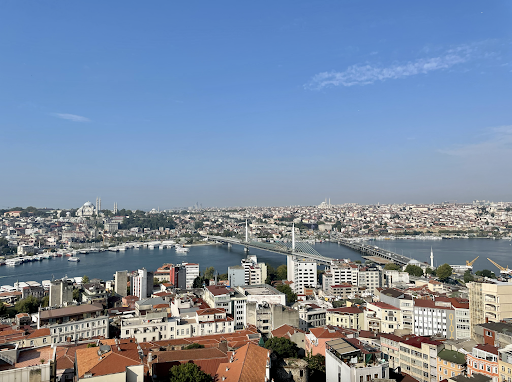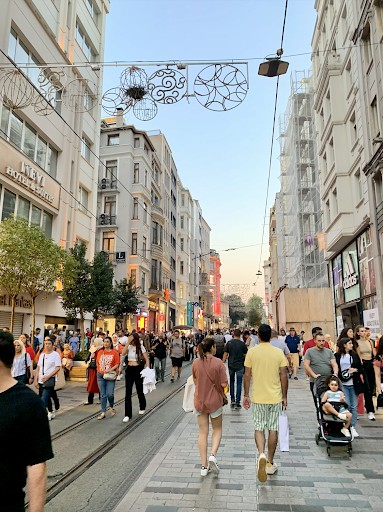Exploring Istanbul, A Tale as Old as Time
Istanbul is a mysterious and complex puzzle: where the human meets the divine, the East blends with the West, and the past intersects with the present. A city of secrets and contradictions, it still remains unsolved.
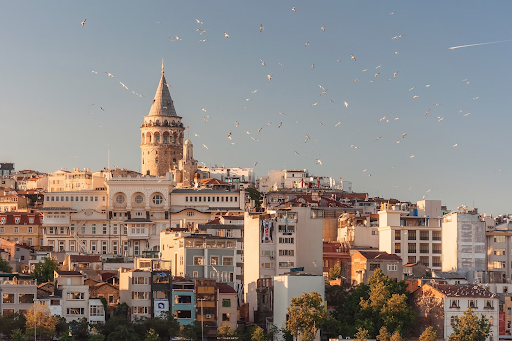
The Galata Tower dominates the Istanbul skyline, standing out from rows of apartment buildings. From being used as a lighthouse to a dungeon, the tower was first built in the Byzantine Empire and is now a museum and sightseeing spot.
As the sun sets over the Bosphorus Strait, the line between European and Asian Turkey darkens to a blur. The Istanbul waters at dusk appear dappled and somewhat turbulent, but ferryboats and cargo move about as usual. Whether it is dated Ottoman buildings or bustling ports overlooking the waterfront, the Bosphorus keeps its calm, giving the surrounding city its strength and lifeblood.
Resting on the edge of the Bosphorus is the Dolmabahçe Palace, an aged Ottoman structure whose gleaming reflection dims into nothing more than a shadow and a monobloc outline. But take a few steps past the waterbank, and the city springs to life. Crowds line up outside of kebab and baklava shops. Restaurateurs and shopkeepers greet passersby with smiles and samples, announcing discounts or the soup of the day before hurrying back inside. And in every corner of nearly every district, stray cats can be found lazily perching on mosque steps or stealthily inching along store awnings, roaming in and out of people’s daily lives.
As Turkey’s cultural capital and largest city, Istanbul houses 39 districts and a population of over 15 million from all walks of life. Carrying over 2,500 years of history, the city and its livelihood have withstood the test of time, ever since the construction of the Byzantine Yoros Castle to the collapse of the Ottoman Empire in the wake of the 20th century.
Istanbul is a city of endlessly colliding identities. From the renowned Hagia Sophia to rows of dilapidated apartment buildings in the district of Fatih, the city is a window into the past, carefully balancing the remnants of a lost empire with today’s demands for modernity.
“In truth, there are multiple Istanbuls — clashing, competing, struggling and, at times, coexisting,” wrote Turkish novelist Elif Shafak in The New York Times. “Imbued with a restless energy, spanning two continents, it is constantly changing, still searching for itself.”
I visited Istanbul in August 2022. After sifting through hundreds of photos and travel blogs, my breath hitched with excitement as I stepped off the plane at 5:30 in the morning. Without even thinking about the eight-hour jet lag, I had made a detailed itinerary to explore the landmarks of Istanbul: the Hagia Sophia, Blue Mosque, Galata Tower, all the tourist must-sees. However, I arrived in a city strikingly different from my expectations. Instead of a bright and bustling metropolis, I was welcomed by rain, dark skies, and the constant honking of taxi cars in the midst of a smoky gray fog.
That evening, I took a walk near Taksim Square and the narrow alleyways of Beyoğlu, each one narrow and worn-down but just as alive and hectic. While I did not visit a single destination on my list, I did catch a glimpse of the Istanbul that award-winning Turkish author Orhan Pamuk described in his memoir Istanbul: Memories and the City. The same city described by TripAdvisor and UNESCO as glorious and even magical was equally filled with melancholy, confusion, and mystery.
“To see the city in black and white is to see it through the tarnish of history: the patina of what is old and faded and no longer matters to the rest of the world,” Pamuk wrote, dedicating a chapter in this perspective. “Even the greatest Ottoman architect has a humble simplicity that suggests an end-of-empire gloom, a pained submission to the diminishing European gaze and to an ancient poverty that must be endured like an incurable disease.”
While Istanbul did, at times, resemble Pamuk’s “black-and-white gangster film” or “shadow world,” it was also a place filled with gray, varyingly shaded by dreams and reality. Amid the morning’s rain, I saw a man rushing down the streets of Beyoğlu, carrying an entire crate (along with another two full bags!) of bread, or ekmek in Turkish. Even on days when the rain is reverberating and the sky is translucent, the city still awakens, soothing and subdued.
The air of Istanbul, while melancholy and somewhat sorrowful, breathes life into the city, subtly yet constantly. Istanbul may be aged, but it is honest and heartfelt. It is raw, real, and unfeigned.
The Rise and Fall of the Ottoman Empire
Istanbul’s origins take root around 657 BCE. King Byzas of Megara, leading a group of Greeks, captured the region from pastoral Thracian tribes and settled there for its strategic geographical location. This earned the city the name Byzantium, which slowly evolved into Constantinople in 330 AD.
Constantinople and the rest of the Byzantine Empire continued to thrive, becoming the centerpiece of commerce and culture that straddled both Europe and Asia. Its success, however, made it a target for outside attacks and attempts to conquer it. In 1453, after centuries of fending off troops from the Middle East, Constantinople fell to Sultan Mehmed II and the Ottoman Turks. It was during this time when people began using the name Istanbul, a term derived from the Greek phrase “is tin poli” meaning “in the city,” though the government did not officially rename the city until centuries later in 1930.
Perhaps the most influential Sultan in Turkish history is Süleyman the Magnificent, the tenth and longest-reigning leader of the Ottoman Empire from 1520 to 1566. From seizing control of Hungary to occupying Iraq, Süleyman cemented the Ottoman military and economic legacy through territorial expansion and prosperous trade. Under his rule, the empire reached its “Golden Age.”
However, all good things eventually come to an end. After Süleyman’s death in 1566, the quality of Ottoman leadership declined rapidly. Coupled with the rise of nationalist uprisings within its territories and competition from European powers, the empire’s military and government were unable to keep up with the technological and social changes brought about by the Industrial Revolution. Its economy stagnated, and without proper infrastructure or reform, the Ottoman Empire soon became known as the “Sick Man of Europe.”
As a result of continued weaknesses in foreign policy and lack of military might, Western powers increasingly encircled the empire in the early 20th century. During World War I, Ottoman leaders signed the Armistice of Mudros, eventually resulting in the partitioning and death of the empire. Five years later, in 1923, the Allied Powers and the fallen empire signed the Treaty of Lausanne, officially recognizing the newly formed Republic of Turkey.
Army officer and revolutionary Mustafa Kemal Atatürk rose to power as the nation’s first president. Often referred to as the Founding Father of modern Turkey, Atatürk made a number of progressive reforms, such as abolishing Islam as the state’s religion, implementing a new Latin alphabet, and improving women’s rights to education and voting. Through these reforms, he instilled a newfound sense of nationalism in the ruined empire, shaping Turkey into the industrialized nation it is today.
“Still, the melancholy of this dying culture was all around us,” wrote Pamuk. “Great as the desire to westernize and modernize may have been, the more desperate wish was probably to be rid of all the bitter memories of the fallen empire, rather as a spurned lover throws away his lost beloved’s clothes, possessions, and photographs.”
Urban Dynamics
Istanbul did not immediately transform into a different, modern place after the establishment of Turkey. In fact, many areas worsened: late Ottoman mansions became “dilapidated brick shells with gaping windows and broken staircases darkened by bracken and untended fig trees,” and it wasn’t until the late 1950s that most of them were “burned down or demolished to make way for apartment buildings.”
“I sometimes think myself unlucky to have been born in an aging and impoverished city buried under the ashes of a ruined empire,” Pamuk continued. “But a voice inside me always insists this was really a piece of luck.”
Because in Istanbul, history is everywhere. There are more than 3,000 mosques throughout the city, ranging from UNESCO World Heritage sites to smaller, self-effacing wooden buildings.
As I stood in line for the Hagia Sophia — a mosque described by many as the centerpiece of the Eminönü district or even the whole of Istanbul — I heard whispers among my parents and other families. Albeit a combination of different languages, people’s eyes and faces glistened with the same kind of wonder, the awe of something so large and intricate and the realization of its endurance through the ages. Their reactions are a testament to the power of art, faith, and human ingenuity.
With the intersection of ancient and modern inevitably comes vulnerability and the need for preservation. The Blue Mosque, just a few steps away from the Hagia Sophia, is currently undergoing extensive renovation. While still open to worshippers and tourists, its remarkable blue tiles are covered by scaffolding, making it incredibly difficult, if not impossible to admire.
A few blocks away is the Basilica Cistern, which reopened in July after five years of restoration. Built by Byzantine Emperor Justinian I in 542 AD, the ancient reservoir is an underground chamber with hundreds of marble columns rising from the water. In Turkish, the cistern is referred to as Yerebatan Sarayı, or “Subterranean Palace.”
A conversation about Istanbul’s famous historical structures would likely never end — the depth of Turkey’s history exceeds the limits of any prose. Instead, the city’s heartbeat is made up of its people and local culture.
Istiklal Street, in the district of Beyoğlu, is a bustling pedestrian street home to rows upon rows of small businesses and restaurants. The street is over 3 kilometers long and is lined with restaurants, boutiques, cafés, art galleries, and more.
Sütiş Kebap Dünyası, in particular, is a kebab shop that captures the attention of locals and tourists alike. Behind its fairly unassuming entrance is a three-story restaurant, where waiters rush up and down the narrow staircase delivering platefuls of roasted meat, salads, and bread. Found on every table — and likely in every other restaurant in Istanbul — is the nation’s signature Turkish tea, served in small curved glasses with traditional sugar cubes.
Another staple is pomegranate juice. A symbol of prosperity and abundance, pomegranates are prominent in Mediterranean cuisines and are native to Turkey. From street juicers serving cups of ruby-red juice to wedding attendees smashing pomegranates on floors, Istanbulites ensure the fruit is among one of, if not the most adored in their culture.
On November 13th, 2022, Istiklal Street suffered a deadly bombing that killed 6 and injured 81. Considered to be a terrorist attack, the explosion sent shockwaves throughout the city and the world. Although it was not the first time Istanbul has seen terrorism, the chaos and uncertainty remained a potent reminder that even a lively, radiating place like Istiklal is fragile. Since then, the street’s livelihood has dimmed — a sense of solemnity has washed over the surrounding area.
Aside from its direct impact on the people, the Istiklal bombing hints at something bigger: renewed violence in the Middle East. President Recep Tayyip Erdoğan has blamed Syrian-Kurdish separatist groups like the Kurdistan Workers’ Party (PKK) and the People’s Protection Units (YPG) for the bombing, threatening that Turkey “will attack [Syria] when the time is right.” At a time of economic downturn and upcoming presidential elections, President Erdoğan’s incentive to cement Turkish regional hegemony is clear.
When I told my friends about my trip, I was met with disbelief and concern: “Isn’t it dangerous?” “Seriously?” “I thought you were joking about going to Turkey.” I realize that in today’s world, where Turkey holds a rather negative perception among the general public and is becoming increasingly influential in global politics, it is more important than ever to separate the government from the people.
Remembering Istanbul’s Silences
While the Turkish national identity is incredibly strong, it is also unexplainably complicated. Turkey’s independence and progression do not come without their faults; the most well-known — and the most unspeakable — of which is the Armenian Genocide. During World War I, in an effort to unify the country and eliminate foreign rivalry, the Young Turks engaged in the ethnic cleansing of more than 1.5 million Armenians. To this day, the Turkish government consistently attempts to reframe history, prosecuting anyone who even speaks of the genocide and removing knowledge of the event from children’s educational curriculums.
Today’s Turkey is increasingly autocratic. By monopolizing state institutions and removing constitutional limits on power, Erdoğan and his government have turned a blind eye to democratic backsliding in the name of anti-terrorism and security.
Authorities have increased crackdowns on free speech at an alarming rate. In fact, Turkey leads the world in imprisoned journalists, and recently passed a new “disinformation law” in October. This policy tightens social media regulation and allows for government censorship through vaguely defined provisions and jail time — even for just a retweet.
Orhan Pamuk and Elif Shafak, whose voices guide this article, are two authors who are inextricably tied to Istanbul – past and present. They are connected not just through their fervor for the city, but through their commitment to empowering the marginalized and addressing the questions that no one answers: What does it mean to be an Istanbulite? What does it mean to be Turkish? What does it mean to be a writer in Turkey?
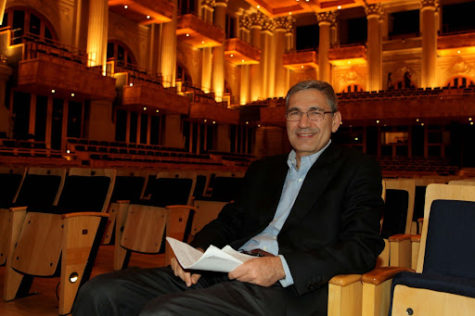
“We are a society of amnesiacs,” Shafak wrote in the Condé Nast Traveler. “Hence the city remains full of stories, but also of silences. It was those silences that I wanted to give voice to.”
In 2006, Shafak was put on trial (and later acquitted) for writing The Bastard of Istanbul, a novel that referred to the 1915 ethnic cleansing of Armenians as genocide. In 2019, she was once again investigated, this time for writing about sexual violence and women, children, and minority rights at large.
Similarly, Orhan Pamuk has been prosecuted twice for “insulting Turkishness,” once in 2006 during an interview and most recently in 2021 after writing Nights of Plague. After winning Turkey’s first Nobel Prize, he only stood out more and more to authorities.
“A million Armenians and 30,000 Kurds were killed in this country, and I’m the only one who dares to talk about it,” he said in a 2005 interview.
Striking a balance between advocating for free speech and avoiding public backlash, Pamuk cleverly weaves political discourse into fiction. In his 2014 novel A Strangeness in My Mind, the main character Mevlut navigates life as a poor Istanbul street vendor, joined by a variety of politically diverse characters — a revolutionary Kurdish friend, ultra-nationalists, political Islamists — all while writing love letters and selling boza, a traditional Turkish drink.
The Turkish government’s crackdown on freedom of expression has greater implications than just its writers — it expands to ordinary citizens and tourists alike. Many bookstores in Istanbul have closed their doors, and many places have lost their meaning without explanations of their history.
Elif Shafak no longer lives in Istanbul. She moved to London in 2013, in a self-imposed exile to avoid further prosecution.
“One thing I’ve learned ever since I left Istanbul is that we do not forget the places we love,” she wrote. “We do not stop hearing the heartbeat of our motherlands: We simply carry them with us into exile.”
Istanbul’s Modern Motifs
Let us return to the Bosphorus and Pamuk’s Istanbul. The sun sets over the strait once more, but as a whole, over the past few decades, its nighttime landscape has changed significantly. Istanbulites have assimilated into a new, modern culture.
The intersection of ancient and modern manifests itself decisively in Istanbul’s newer districts of Elmadağ, Nişantaşı, Kurtuluş, and Şişli. Collectively known as the New City, these areas of the city have expanded exponentially in recent years, fueled by the government’s profit incentive to attract the wealthy.
While urban planners strive to preserve famous historical monuments in older districts, rapid urbanization plagues the rest of Istanbul just the same. Its skyline is typically made up of jagged, amorphous apartment buildings, but modern skyscrapers have begun looming in the distance.
Orhan Pamuk has resided in Istanbul for the majority of his life, only leaving periodically to escape vilification for his writing.
“Most of the Istanbul of my childhood is demolished,” he wrote. “[The government will] keep destroying historic buildings, because there is a sentiment that we must eat the past to improve today.”
Istanbul has seen massive gentrification since the 1980s, when housing developers began replacing old, worn-down apartment buildings with new, luxurious high-rises. In neighborhoods lining the Bosphorus, wealthy residents have flowed into the area in large numbers, with the intention of escaping the urban traffic and pollution. Consequently, many farmers and fishermen have been displaced.
Fikirtepe is one district where urban transformation has turned “toxic,” according to a 2018 Reuters article. Not only are residents frequently kept in the dark about development projects, but gentrification has fragmented communities on a broader scale. Many native Istanbulites have moved out of the district due to unaffordable housing and construction pollution — the latter being so harmful to the extent that residents cannot open their windows.
Outside of gentrification and district-level change, Istanbul is also transforming subtly. The city streets, now illuminated by bright white lights instead of a hushed modest orange, have taken on a new kind of character. As described by Orhan Pamuk, the fluorescent white light that flooded the streets was “something cold,” something that “filled hospitals, warehouses, factories, waiting rooms and refrigerators” and “was to be avoided.”
As I walked through the streets of Tarlabaşı, I wondered when Pamuk noticed the quiet transition of the city’s nightscape. But after reading his New York Times piece ‘The Changing Colors of Istanbul,’ I doubt he knows either.
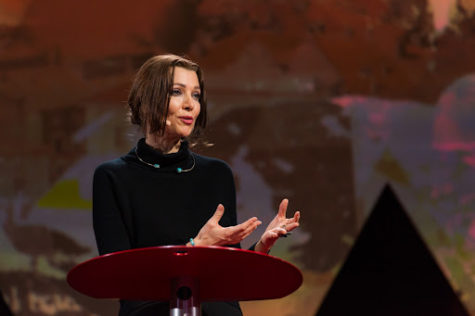
Afterthoughts
It is often the smallest things about Istanbul that evoke the strongest nostalgia and belonging. Elif Shafak recalls “the smell of roasted chestnuts, the taste of a sesame bagel, [and] the smell of salty seawater in the breeze,” adding that even from more than 1,500 miles away, she is still rooted in Istanbul.
Shafak, in my view, is extraordinarily brilliant in her prose and articulation. I recommend her article ‘Read Your Way Through Istanbul,’ part of The New York Times ‘Read Your Way Around the World’ series, where she explores Istanbul through a literary lens and how its voices bring the city to life.
Istanbul is true and sincere, and simultaneously enigmatic in every way. Pamuk sums it up best with hüzün, the Turkish word for melancholy. It is not so much a weight on the city’s shoulders as it is a “way of looking at life” that is all around, a state of mind that is somewhat spiritual and “ultimately as life-affirming as it is negating.”
Istanbul may be complicated or confusing or clashing, but it is timeless. And if you look hard enough, within the crevices of cobblestone streets or among the alleyways of Arnavutköy, you can sometimes find a little bit of magic.
“I sometimes think myself unlucky to have been born in an aging and impoverished city buried under the ashes of a ruined empire,” Pamuk continued. “But a voice inside me always insists this was really a piece of luck.”
Charlotte Zhou is an Editor-in-Chief for ‘The Science Survey.’ In addition to writing and editing articles, she constructs the online crossword and...

